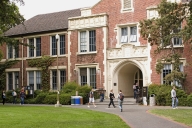You have /5 articles left.
Sign up for a free account or log in.

A new financial assistance program at Duquesne University aims to recruit and support transfer students.
Duquesne University
Duquesne University, a private Catholic institution in Pittsburgh, is doubling the amount of financial help available to incoming transfer students who reside in the state.
A new initiative at the university, launching in summer 2023, will automatically match the amount transfer students receive through the PA State Grant Program, a financial assistance program for Pennsylvania residents that offers $500 to $5,750 per year to students depending on their level of financial need. The grant-matching program will double the grant, up to $5,100 annually, for as many years as it takes for transfer students to graduate. The university previously only matched the grant for first-year students, up to $2,500 per year.
The initiative is part of a broader effort to attract transfer students to the university as it struggles with enrollment declines, said Joel Bauman, senior vice president for enrollment management at Duquesne. The institution also has transfer agreements with local community colleges and a core curriculum that allows credits to transfer if students fulfill certain competencies, as opposed to evaluating each of their courses individually for an equivalent course at the university.
Bauman noted that colleges in the Northeast are already facing a demographic cliff, a decline in the number of traditional college-age students that is expected to hit other regions of the country in the next couple years.
The pandemic exacerbated what was already a downward trend in enrollment at Duquesne and many other colleges and universities across the country. Student head count fell from 6,074 to 5,110 between fall 2018 and fall 2022, according to university data.
“We’ve been off that ledge in this region for a few years,” said Bauman, referring to the demographic cliff. Focusing on transfer students “became obvious as an approach to put a floor under that and really address an opportunity for a group of students we may not have … intentionally been as creative with.”
The university currently welcomes about 200 to 250 transfer students per year, and Bauman hopes that number will grow. He said local transfer students from community colleges are often adults and less likely to have parental help with paying for college. They’re also more likely to be rooted in the region. He also believes students who went to college out of state and want to return home because of family responsibilities, financial hardship or other reasons might benefit from the grant-matching program, as well.
Some higher ed experts believe Duquesne’s efforts are part of a growing trend.
Lara Couturier, a principal at Sova, a higher education consulting firm, predicts more four-year colleges and universities are going to invest in recruitment strategies and supports for transfer students if enrollment trends remain unpredictable. Sova oversees the Beyond Transfer Policy Advisory Board, a group of experts dedicated to transforming the transfer process (which also contributes blog posts to Inside Higher Ed).
But Duquesne is among “the first to really step into the space and invest and communicate to students that this is a really affordable opportunity and a smart investment,” she said. “I would say the field is talking a lot about the potential of transfer students and that they’re an important group to serve and that they can be an important investment for institutions that need to increase enrollment, but I haven’t seen a lot of action following that discussion.”
Couturier said university leaders have long failed to prioritize recruiting transfer students and offering them sufficient financial aid. She believes that’s in part because administrators see transfers as a less lucrative investment than first-year students because they may enroll for fewer years and pay tuition over a shorter time period.
“There’s such an intense focus on short-term rewards and a presumption that students who start and stay will produce a higher revenue margin for institutions,” she said. “There are a number of research reports that show that there’s just a real differential in how transfer students are treated and how much they’re prioritized in discussions at the cabinet level.”
Tania LaViolet, director of the bachelor’s attainment portfolio at the Aspen Institute’s College Excellence Program, believes there’s growing interest among leaders of four-year institutions in attracting transfer students—and not just because of enrollment declines.
“Higher ed is kind of facing a crisis now in terms of public distrust of higher education or a skepticism of the value of higher education,” she said. So campus leaders are “really looking to build better and stronger relationships with communities that have been historically underserved to build back that trust.”
She believes that offering financial assistance is a winning strategy, if it’s part of a more “holistic” plan to ensure students’ credits transfer and they have supports after they enroll. She noted that a data analysis by the Aspen Institute found that about a third of transfer students end up at private institutions, such as Duquesne, but these institutions have lower completion rates for transfer students than their public counterparts.
“Build the trust with community colleges by showing them value, and that will build in the years to come when they go back to their communities and say, ‘This is worth doing. Look what it’s done for me,’” she said.
Bauman characterized the grant-matching program as an “access opportunity to the right-fit education, the quality education that students may not have thought is available to them.”
“We want to be known as an institution that’s welcoming to transfer students, traditional-age and new traditional transfer students, as a first priority,” he said.









